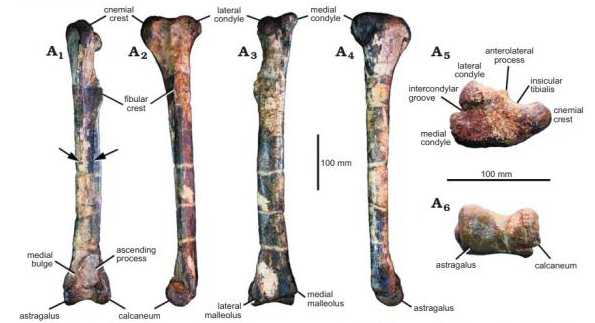Two New Theropod Dinosaurs from Thailand
Phuwiangvenator yaemniyomi and Vayuraptor nongbualamphuensis
Two new species of theropod dinosaur have been described from partial fossil remains excavated from strata associated with the Sao Khua Formation of north-eastern Thailand. It is likely that both these meat-eating dinosaurs have affinities with the Megaraptora and their discovery lends weight to the idea that the Megaraptoridae and their near relatives probably originated in Asia.
The dinosaurs have been named Phuwiangvenator yaemniyomi and Vayuraptor nongbualamphuensis, Phuwiangvenator has been described as a megaraptoran whilst the exact taxonomic position of Vayuraptor remains uncertain, although the authors of the scientific paper suggest that it too was a member of the clade of dinosaurs with long-snouts, highly pneumatised skeletons and with large claws.
Bones in Approximate Life Position from the Right Foot of P. yaemniyomi
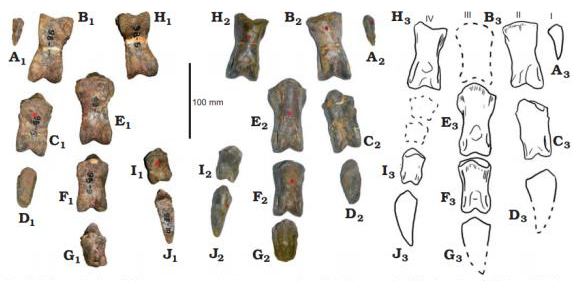
Picture credit: Samathi et al
Lower Cretaceous Theropod Dinosaurs
The fossils were found nearly twenty-five miles apart, but the strata in which the fragmentary fossil material was found is contemporaneous and dated to the upper Barremian stage of the Lower
Cretaceous.
The first identified specimens of P. yaemniyomi were found by Preecha Sainongkham, a team member at the Phu Wiang Fossil Research Centre and Dinosaur Museum back in 1993. The Phu Wiang Mountain region is highly fossiliferous and numerous vertebrate fossils representing the fauna of a low-lying, inland, lacustrine environment have been discovered over the years. The first dinosaur bone known from Thailand was found in 1976, a scrappy bone fragment that was assigned to the Sauropoda. This fossil was found by Sudham Yaemniyom, who was at the time a geologist with the country’s Department of Mineral Resources, Bangkok. The species name of Phuwiangvenator yaemniyomi honours his contribution to the geology and palaeontology of Thailand.
Phuwiangvenator is the larger of the two theropods, it is believed to have measured around 5.5 to 6 metres in length. It is known from dorsal and sacral vertebrae plus elements of the hind limbs and feet. All the fossil material was found within the same bedding plane and within an area of just 5 square metres.
Views of the Right Tibia (A1 – A6) and a Proximal View of the Left Tibia (P. yaemniyomi)
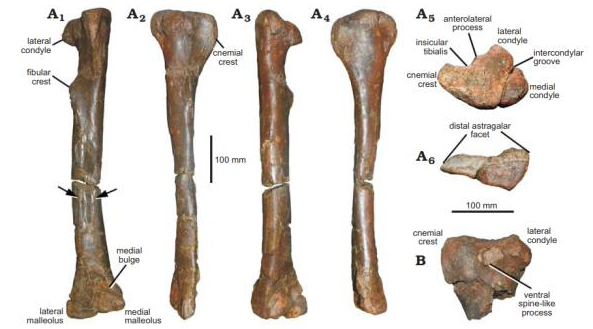
Picture credit: Samathi et al
Vayuraptor nongbualamphuensis – Raptor of the Wind God
The fossils associated with Vayuraptor were found in 1988. It is known from a left tibia and ankle bones. The genus name is from the Sanskrit for “Vayu”, a God of the Wind and the Latin term “raptor”, which means thief. Analysis of the single lower leg bone indicates that like Phuwiangvenator, this dinosaur was a fast-running, cursorial predator. The fossils of both dinosaurs are now part of the extensive dinosaur fossil collection at the Sirindhorn Museum in Kalasin Province. This museum houses the largest collection of dinosaur fossil bones in north-eastern Thailand.
Analysis of the Tibia Suggests that Vayuraptor was a Fast Runner
Picture credit: Samathi et al
Megaraptora Originated in Asia
The establishing of at least one of these dinosaurs as a member of the Megaraptora clade, possibly both, helps to support the hypothesis that in south-eastern Asia during the Early Cretaceous, it was the Megaraptora that were diverse and playing the role of apex predators. This is in contrast to other ecosystems elsewhere in the world, that were dominated by different kinds of theropod dinosaur. A basal member of the Megaraptora, Fukuiraptor kitadaniensis is known from the Lower Cretaceous (Barremian) of Japan, these two dinosaurs are also (most likely), from the Barremian. Their identification supports the idea that these fast running, lightly built predators evolved in Asia.
A Model of the Basal Megaraptoran Clade – Fukuiraptor
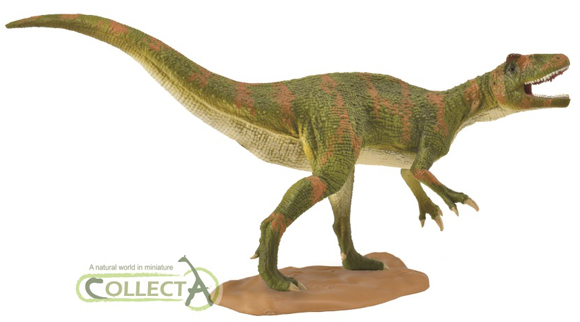
The picture (above) features a CollectA Fukuiraptor model.
To view the range of not-to-scale CollectA prehistoric animals: CollectA Prehistoric Life Models and Figures.
An Early Cretaceous Heyday for the Megaraptorans
Fossils of this type of meat-eating dinosaur have been reported from the Barremian to the Aptian faunal stage of the Early Cretaceous. The authors of the scientific paper, published in the scientific journal “Acta Palaeontologica Polonica”, note that several specimens of megaraptoran dinosaurs have been recorded from the Aptian of Australia and one reported from the later Albian faunal stage of South America. Megaraptorans are known from the Late Cretaceous but seem to indicate that by around 90 million years ago, “megaraptors” had a more limited range and seem to have been confined mostly to South America.
A Typical Illustration of a Member of the Megaraptoridae Family of Theropod Dinosaurs
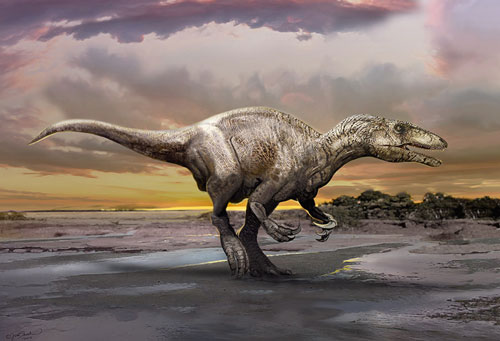
Picture credit: Jan Sovak (University of Alberta)
Commenting Upon the Theropod Dinosaurs
A spokesperson from Everything Dinosaur commented:
“The identification of these theropod remains that had been known about for more than twenty-five years, has been partially resolved. Hopefully, more fossil material associated with the Vayuraptor genus will be found in Thailand so that it too can be more definitively placed within the Megaraptora clade. Given the extent of the fossil discoveries made from the Phu Wiang Mountain region thus far, it is highly likely that more new dinosaurs will be named and described from Thailand in the future.”
To read an article about a Late Cretaceous member of the Megaraptoridae family from South America that was reported upon in 2018: A New Member of the Megaraptoridae from the Late Cretaceous of South America (Tratayenia rosalesi).
The scientific paper: “Two new basal coelurosaurian theropod dinosaurs from the Lower Cretaceous Sao Khua Formation of Thailand” by A. Samathi, P. Chanthasit and P. Martin Sander published in Acta Palaeontologica Polonica.
Visit the Everything Dinosaur website: Everything Dinosaur.


